Reign of Charles IX
In his role as lieutenant-governor of Burgundy, he prosecuted the Protestant population harshly, an action for which he was cautioned by Catherine de' Medici in 1561, who urged him to have patience. With the publication of the Edict of Saint-Germain in January 1562, he allied with the mayor of Dijon in opposing it, and the Parlement of Dijon refused to register the edict.
First war
He served the crown loyally during the civil wars that broke out after the Massacre of Wassy. In the spring of 1562, he prepared to attack Mâcon, requesting a militia be raised by Dijon for the purposes of reconquest. Having seized the city, Beza would claim Tavannes enriched himself to the sum of 60,000 livres in the looting that followed. Alongside the capture of Mâcon he would foil attempted coups in Dijon and Chalons. In May he summoned all Protestant preachers in Dijon to assemble outside the Hôtel de Ville so that they might be sent elsewhere, with the penalty of death for any who failed to attend. To support his military efforts in recapturing Chalons after it was seized by the baron des Adresse several thousand mercenaries would be hired from Switzerland and Germany.
With peace declared in 1563, Catherine would write to him as she had in 1561, urging him to restrain the vindictive urge of the Dijon Parlement to punish Protestants and allow them to practice freely in accordance with the Edict of Amboise. The queen mother would ultimately draw close to Tavannes, seeing him and Marshal Vielleville as useful counterweights to the Guise and Montmorency factions at court. In 1564 with the royal court on tour of France, Tavannes staged a grand welcome for them in Dijon, throwing a large military parade.
Second war
After the victory at the battle of Saint Denis Tavannes and Guise monitored the border, hoping both to prevent reiters coming to Condé's aid, and to achieve juncture with the Comte de Manfeldt; the crossing of 6000 reiters thwarted their plans and forced them to retire from the border. In 1568, after the conclusion of the second war with the Peace of Longjumeau he established a Confraternity of the Holy Ghost in Dijon, a violation of the edict's terms. The purpose of the league was to raise funds and prepare arms in the eventuality of conflict breaking out again. The success of the confraternity in bringing about abjurations in Dijon led to imitation orders being founded across Burgundy, such as in Autun and Chalon-sur-Saône. During the short peace Catherine implored Tavannes to enforce the terms of the edict in his territory.
Third war
With the peace collapsing and the Protestant nobles moving into opposition, Tavannes allowed his correspondence on the matter to be intercepted by their agents, alerting them to the fact they were due to be arrested. Whilst he opposed them politically he felt the planned arrest was a dishonourable method, the warning provided allowed them to flee south to La Rochelle and take up arms. During the third civil war he led the crown to victory at the battles of Jarnac and Moncontour commanding armies under the nominal leadership of Anjou. In the wake of the latter victory Tavannes and Cossé counselled the king to make peace while he had the advantage, but the government instead set about a siege of Saint-Jean-d'Angély. The siege would prove a disaster for the royal army, destroyed by disease and lack of pay. As a reward for his service, and compensation for being dispossessed of his lieutenant-governorship in Dijon, he was made Marshal of France on 28 November 1570. He was also granted a royal pension from Anjou.
Saint Bartholomew's Day Massacre
In the uneasy peace that followed the third war, Tavannes was opposed to the plans of Coligny to reunite the kingdom through an invasion of the Spanish Netherlands. When Nassau crossed the border in May 1572 and Coligny urged the king to seize the moment, he was one of the figures selected to compose a memoranda against the idea. As one of Catherine's chief confidants and a member of the Conseil Privé he was intimately involved in the meetings that took place after the attempted assassination of Admiral Coligny in which the decision to liquidate the senior Protestant leadership was taken. According to the memoirs written much later by his son, he had argued for the life of Navarre and Condé during the meeting; however, the fact the memoirs were written during Navarre's reign as king makes this hard to take at face value. In October the same year he was appointed as governor of Provence and Admiral of the Levant. He traded the governorship of Provence to Albert de Gondi on condition that Gondi hand over Metz to his son.
Death
He died in his castle at Sully, and was buried in the Sainte Chapelle of Dijon. His memoirs, edited and published by his son around 1620, are an important primary source for the period. [36]

Charles IX was King of France from 1560 until his death in 1574. He ascended the French throne upon the death of his brother Francis II in 1560, and as such was the penultimate monarch of the House of Valois.

Michel de l'Hôpital was a French lawyer, diplomat and chancellor during the latter Italian Wars and the early French Wars of Religion. The son of a doctor in the service of Constable Bourbon he spent his early life exiled from France at Bourbon's and then the emperors court. When his father entered the service of the House of Lorraine, he entered the patronage network of Charles, Cardinal of Lorraine. Through his marriage to Marie Morin, he acquired a seat in the Paris Parlement. In this capacity he drew up the charges for the king, concerning the defenders of Boulogne who surrendered the city in 1544, before taking a role as a diplomat to the Council of Trent in 1547. The following year he assisted Anne d'Este in the details of her inheritance to ensure she could marry Francis, Duke of Guise.

Gaspard de Coligny, seigneur de Châtillon, was a French nobleman, Admiral of France, and Huguenot leader during the French Wars of Religion. He served under kings Francis I and Henry II during the Italian Wars, attaining great prominence both due to his military skill and his relationship with his uncle, the king's favourite Anne de Montmorency. During the reign of Francis II he converted to Protestantism, becoming a leading noble advocate for the Reformation during the early reign of Charles IX.
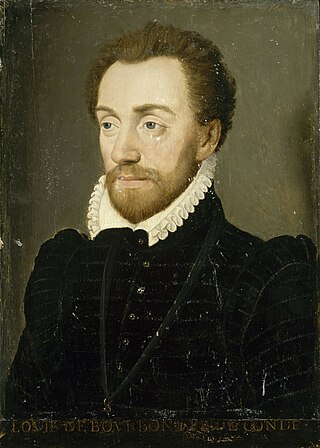
Louis de Bourbon, 1st Prince of Condé was a prominent Huguenot leader and general, the founder of the Condé branch of the House of Bourbon. Coming from a position of relative political unimportance during the reign of Henri II, Condé's support for the Huguenots, along with his leading role in the conspiracy of Amboise and its aftermath, pushed him to the centre of French politics. Arrested during the reign of Francis II then released upon the latter's premature death, he would lead the Huguenot forces in the first three civil wars of the French Wars of Religion before being executed after his defeat at the Battle of Jarnac in 1569.

François de Montmorency, 2nd Duke of Montmorency was a French noble, governor, diplomat and soldier during the latter Italian Wars and the early French Wars of Religion. The son of Anne de Montmorency, favourite of the king and Madeleine of Savoy, Montmorency began his political career during the coronation of Henri II in 1547. With the resumption of the Italian Wars in 1551 he fought at the capture of Chieri, the famous defence of Metz and the defence of Thérouanne. In the latter engagement he was captured by Imperial forces, and put up for ransom. He would spend the next three years in captivity before returning to France in 1556. Returning to the conflict immediately he participated in the disastrous Saint-Quentin campaign in which the French army was destroyed and his father captured. After serving as a lieutenant in Picardie he found himself gaining advantage on the death of Henri II, the new Guise regime compensating the Montmorency family for their seizure of the grand maître title with the provision of a Marshal baton to Montmorency.

The Edict of Saint-Germain, also known as the Edict of January, was a landmark decree of tolerance promulgated by the regent of France, Catherine de' Medici, in January 1562. The edict provided limited tolerance to the Protestant Huguenots in the Catholic realm, though with counterweighing restrictions on their behaviour. The act represented the culmination of several years of slowly liberalising edicts which had begun with the 1560 Edict of Amboise. After two months the Paris Parlement would be compelled to register it by the rapidly deteriorating situation in the capital. The practical impact of the edict would be highly limited by the subsequent outbreak of the first French Wars of Religion but it would form the foundation for subsequent toleration edicts as the Edict of Nantes of 1598.

Jacques de Savoie, duc de Nemours was a French military commander, governor and Prince Étranger. Having inherited his titles at a young age, Nemours fought for king Henri II during the latter Italian Wars, seeing action at the siege of Metz and the stunning victories of Renty and Calais in 1554 and 1558. Already a commander of French infantry, he received promotion to commander of the light cavalry after the capture of Calais in 1558. A year prior he had accompanied François, Duke of Guise on his entry into Italy, as much for the purpose of campaigning as to escape the king's cousin Antoine of Navarre who was threatening to kill him for his extra-marital pursuit of Navarre's cousin.

Jacques d'Albon, Seigneur de Saint-André was a French governor, Marshal, and favourite of Henri II. He began his career as a confident of the dauphin during the reign of François I. Saint André and the prince were raised together under the governorship of his father at court. In 1547, at the advent of Henri's reign, he was appointed as his father's deputy, serving as lieutenant general for the Lyonnais. Concurrently he entered the king's conseil privé and was made a Marshal and Grand Chamberlain.
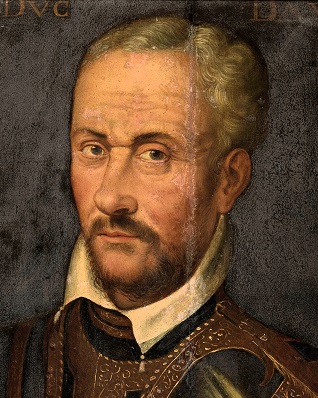
Claude II de Lorraine, duc d'Aumale was a Prince étranger, military commander and French governor, during the latter Italian Wars and the early French Wars of Religion. The son of the first Duke of Guise he started his career in a pre-eminent position in French politics as a son of one of the leading families in the court of Henri II of France. Upon the death of his father in 1550, Aumale inherited the governorship of Burgundy from his father, and the duchy of Aumale from his brother who assumed the titles of Guise. Aumale was made colonel-general of the light horse by the new king and fought in Italy, Alsace and Picardie between 1551 and 1559. While leading the light cavalry during the defence of Metz he was captured, and held for the next two years, until his mother in law Diane de Poitiers paid his ransom. He achieved success at the siege of Volpiano and played an important role in the capture of Calais for which he was rewarded with the governorship of French Piedmont.

The Peace of Saint-Germain-en-Laye was signed on 8 August 1570 by Charles IX of France, Gaspard II de Coligny and Jeanne d'Albret, and ended the 1568 to 1570 Third Civil War, part of the French Wars of Religion.

The Edict of Amboise, also known as the Edict of Pacification, was signed at the Château of Amboise on 19 March 1563 by Catherine de' Medici, acting as regent for her son Charles IX of France. The Edict ended the first stage of the French Wars of Religion, inaugurating a period of official peace in France by guaranteeing the Huguenots religious privileges and freedoms. However, it was gradually undermined by continuing religious violence at a regional level and hostilities renewed in 1567.
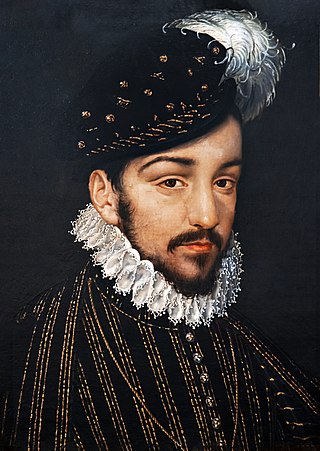
The Peace of Longjumeau was signed on 23 March 1568 by Charles IX of France and Catherine de' Medici. The edict brought to an end the brief second French Wars of Religion with terms that largely confirmed those of the prior edict of Amboise. Unlike the previous edict it would not be sent to the Parlements to examine prior to its publication, due to what the crown had felt was obstructionism the last time. The edict would not however last, and it would be overturned later in the year, being replaced by the Edict of Saint-Maur which outlawed Protestantism at the beginning of the third war of religion.
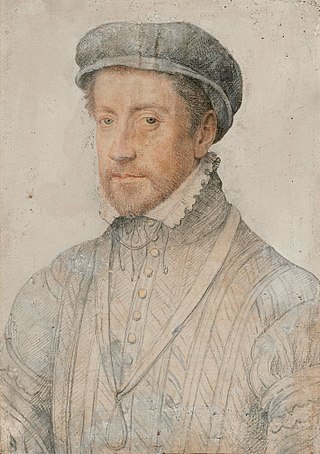
Louis III de Bourbon, Duc de Montpensier was the second Duke of Montpensier, a French Prince of the Blood, military commander and governor. He began his military career during the Italian Wars, and in 1557 was captured after the disastrous battle of Saint-Quentin. When his liberty was restored, he found himself courted by the new regime as it sought to steady itself and isolate its opponents in the wake of the Conspiracy of Amboise. At this time Montpensier supported liberalising religious reform, as typified by the Edict of Amboise he was present for the creation of.

The surprise of Meaux was a failed coup attempt by leading aristocratic Huguenots which precipitated the second French War of Religion. Dissatisfied with their lot, and under the pretext of fear of extermination, Louis, Prince of Condé and Gaspard II de Coligny plotted to seize the king, Charles IX, while he was staying near Meaux. Alerted by the mustering of the Huguenots, the royal court made a dash for Paris, fighting off attempts to break through to them en route. Their plan foiled, the Huguenots laid siege to the city, beginning the second war. The event would be of lasting importance in the reputation it gave its architects for sedition.

Albert de Gondi, duc de Retz seigneur du Perron, comte, then marquis de Belle-Isle (1573), duc de Retz, was a marshal of France and a member of the Gondi family. Beginning his career during the Italian Wars he fought at the Battle of Renty in 1554, and in many of the campaigns into Italy in the following years, before returning to France for the disastrous battle of Saint-Quentin and battle of Gravelines both of which saw the French army savaged.

The siege of Orléans was the final key military engagement of the first French War of Religion. Having lost the Battle of Dreux the rebel Huguenots fell back with their remaining forces to the city. François, Duke of Guise, the only non captive royal commander, moved to lay siege to the town, hoping its capitulation would bring about a total victory for the crowns forces. However, despite reducing the suburbs, he would be assassinated at the siege before he could bring it to a conclusion. As a result the captive Louis, Prince of Condé and Anne de Montmorency at Catherine de' Medici's direction were able to negotiate a compromise end to the first war in the Edict of Amboise.
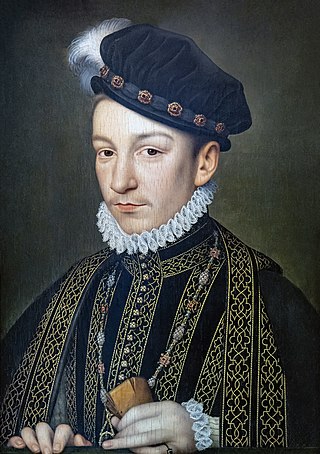
The Edict of Saint-Maur was a prohibitive religious edict, promulgated by Charles IX of France at the outbreak of the third war of religion. The edict revoked the tolerance that had been granted to Protestantism, in the edicts of Saint-Germain, Amboise and the peace of Longjumeau. The edict forbade the exercise of any religion other than Catholicism in the kingdom of France, and gave Protestants 15 days to vacate the kingdom. Ultimately the edict would be overturned in the landmark peace of Saint-Germain-en-Laye at the end of the third religious war in 1570 which restored recognition to Protestantism, alongside many other concessions.

The Edict of Amboise (1560) was a decree that created the framework to separate heresy from sedition, promulgated by the young king Francis II on the advice of his council and mother Catherine de' Medici. The edict was the first promulgated in France that lessened the persecution of Huguenots through the provision of amnesty for past religious crimes on the condition the offender returned to the Catholic fold. The edict was published during the Amboise conspiracy whilst the royal court was resident in the Château d'Amboise and their authority over France was shaken. It would be superseded first by the Edict of Romorantin in May of the same year, then the Edict of July and finally the Edict of Saint-Germain.
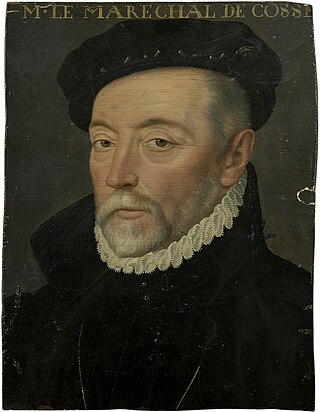
Artus de Cossé, seigneur de Gonnor and Comte de Secondigny (1512–1582), was a Marshal of France, an office he was elevated to in 1567. He served to administer the armies finances during the first of the French Wars of Religion and would lead the royal army in its pursuit of the Prince of Condé during the second civil war. His failure to catch the army led to his dismissal from overall royal command. During the third civil war he would again lead troops, beating a small Protestant force, before being defeated in the final days of the war at Arney-le-Duc. His long history of Politique leanings would push him into the orbit of the Malcontents for which he would be arrested in 1574. In 1576 he would be released and restored to favour before he died in 1582.
Laurent de Maugiron, comte de Montléans was a French military commander and lieutenant-general of Dauphiné during the Italian Wars and French Wars of Religion. Beginning his career during the reign of Henri II he fought at the defence of Metz in 1552, and in the Picardie campaign of 1554. With peace declared in 1559, he returned to Dauphiné, where he worked with the lieutenant-general La Motte Gondrin, in his attempts to stamp out Protestantism in the region.




















